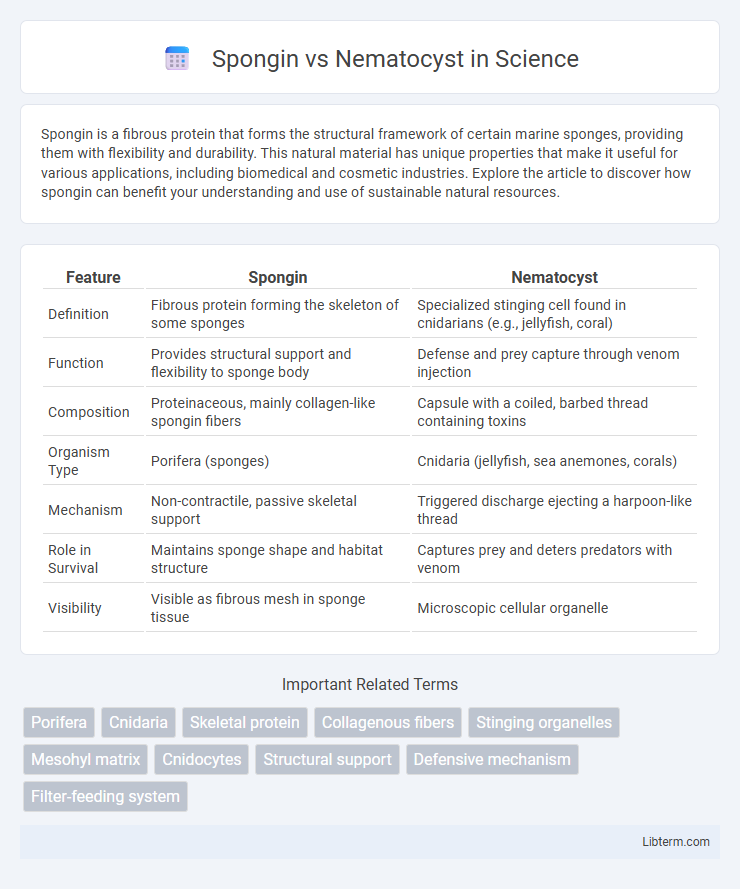Spongin is a fibrous protein that forms the structural framework of certain marine sponges, providing them with flexibility and durability. This natural material has unique properties that make it useful for various applications, including biomedical and cosmetic industries. Explore the article to discover how spongin can benefit your understanding and use of sustainable natural resources.
Table of Comparison
| Feature | Spongin | Nematocyst |
|---|---|---|
| Definition | Fibrous protein forming the skeleton of some sponges | Specialized stinging cell found in cnidarians (e.g., jellyfish, coral) |
| Function | Provides structural support and flexibility to sponge body | Defense and prey capture through venom injection |
| Composition | Proteinaceous, mainly collagen-like spongin fibers | Capsule with a coiled, barbed thread containing toxins |
| Organism Type | Porifera (sponges) | Cnidaria (jellyfish, sea anemones, corals) |
| Mechanism | Non-contractile, passive skeletal support | Triggered discharge ejecting a harpoon-like thread |
| Role in Survival | Maintains sponge shape and habitat structure | Captures prey and deters predators with venom |
| Visibility | Visible as fibrous mesh in sponge tissue | Microscopic cellular organelle |
Introduction to Spongin and Nematocyst
Spongin is a fibrous protein forming the skeleton of certain sponges, providing structural support and flexibility. Nematocysts are specialized organelles found in cnidarians, such as jellyfish and sea anemones, used for defense and prey capture through the discharge of venomous harpoons. Both spongin and nematocysts play crucial roles in their respective organisms, contributing to survival and functionality within marine ecosystems.
Structural Overview of Spongin
Spongin forms the fibrous skeleton of certain demosponges, composed primarily of collagen-like protein that provides flexibility and tensile strength. This organic matrix supports sponge body integrity, enabling resilience in varying aquatic currents without brittleness. Unlike nematocysts, which are specialized stinging organelles in cnidarians used for prey capture and defense, spongin functions purely as a structural framework without any active defense role.
Structural Overview of Nematocyst
Nematocysts are specialized organelles found in cnidocytes of cnidarians, consisting of a capsule containing a coiled, barbed tubule that can rapidly evert to deliver toxins. Structurally, nematocysts comprise a rigid capsule wall made of a collagen-like protein, a pressure-sensitive operculum, and sensory cilia that trigger discharge. Unlike spongin, a collagenous protein forming the flexible skeletal framework in sponges, nematocysts function primarily in defense and prey capture through mechanical and chemical means.
Biological Functions of Spongin
Spongin is a fibrous protein found in the skeletons of certain marine sponges, providing structural support and flexibility crucial for their survival in diverse aquatic environments. Unlike nematocysts, which are specialized stinging cells used by cnidarians for defense and prey capture, spongin primarily contributes to the sponge's mechanical strength and resilience against physical damage. This biochemical composition enables sponges to maintain their porous body structure, facilitating efficient water filtration and nutrient absorption essential for their biological functions.
Biological Roles of Nematocyst
Nematocysts are specialized organelles found in cnidarians, serving as key biological structures for defense and prey capture through rapid toxin injection and entanglement. Unlike spongin, a structural protein forming sponge skeletons, nematocysts enable active interaction with the environment by immobilizing prey and deterring predators. These complex capsules contribute to survival and ecological success in species such as jellyfish, sea anemones, and corals.
Comparative Analysis: Spongin vs Nematocyst
Spongin, a fibrous protein forming the structural framework in sponges, provides flexibility and durability, while nematocysts are specialized stinging organelles unique to Cnidarians used for prey capture and defense. Unlike spongin's passive structural role, nematocysts actively discharge toxins, showcasing a functional divergence between mechanical support and venomous protection. Comparative analysis highlights spongin's contribution to sponge morphology versus nematocysts' biochemical weaponry critical for survival in aquatic ecosystems.
Evolutionary Significance in Sponges and Cnidarians
Spongin, a collagenous protein framework in sponges, represents a primitive evolutionary adaptation for structural support and protection in early multicellular organisms, enhancing their resilience in aquatic environments. Nematocysts, specialized stinging organelles found in cnidarians, signify a more advanced evolutionary development, enabling effective predation and defense through rapid discharge of toxins. The divergence between spongin in Porifera and nematocysts in Cnidaria highlights distinct evolutionary paths driven by ecological niches and survival strategies.
Spongin’s Role in Sponge Skeletal Support
Spongin is a fibrous protein that provides essential structural support in sponges by forming a flexible, resilient skeleton that maintains the sponge's shape and integrity. Unlike nematocysts, which are specialized stinging cells found in cnidarians for defense and prey capture, spongin fibers contribute to the sponge's ability to withstand environmental stress without compromising its porous body. The presence of spongin enhances the durability and elasticity of sponge tissues, facilitating effective water flow and nutrient absorption crucial for sponge survival.
Nematocyst’s Mechanism in Defense and Prey Capture
Nematocysts are specialized stinging organelles found in cnidarians, playing a crucial role in both defense and prey capture through a rapid, high-pressure discharge mechanism that injects toxins into targets. This mechanism involves the explosive eversion of a coiled, barbed thread inside the nematocyst capsule, which delivers venom to immobilize prey or deter predators effectively. Unlike spongin, which provides structural support as a fibrous protein in sponges, nematocysts actively engage in biological interactions by combining mechanical penetration and chemical envenomation.
Importance of Spongin and Nematocyst in Marine Ecosystems
Spongin provides structural support and flexibility to sponges, enabling them to filter vast volumes of water, which enhances nutrient cycling and water clarity in marine ecosystems. Nematocysts, the specialized stinging organelles found in cnidarians such as jellyfish and corals, play a crucial role in predator-prey interactions and defense mechanisms, maintaining ecological balance by controlling populations of various marine species. The combined importance of spongin and nematocysts lies in their contribution to habitat formation, species diversity, and the overall health of marine environments.
Spongin Infographic

 libterm.com
libterm.com